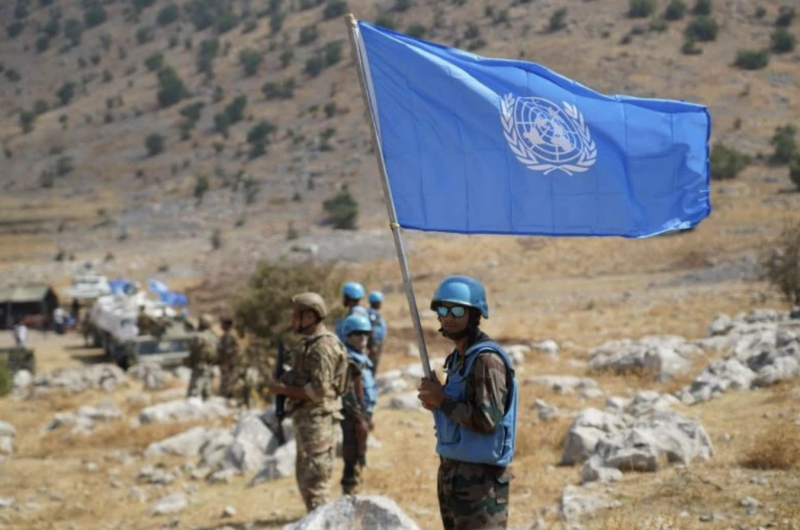
UNIFIL peacekeepers deployed at Kfar Shuba, on the Lebanese-Israeli border. (Credit: Mohammad Yassine/L'Orient-Le Jour)
Behind the scenes of Western diplomacy, preparations for the future are already in motion.
Once the ceasefire is confirmed in Gaza, and Lebanon, attention will turn to recent developments.
For several weeks now, Security Council Resolution 1701 (2006) has been a focal point in discussions.
Its full implementation, encompassing all its clauses — specifically the disarmament of Hezbollah as outlined in Resolution 1559 (2004), which Resolution 1701 repeatedly references —is deemed essential for restoring stability to the southern Lebanese area.
The implementation of the UN resolution is subject to varying interpretations.
Some view referencing Resolution 1701 as a call to revert to the status quo — potentially with minor adjustments — that existed from the end of the July 2006 war until the outbreak of the Oct. 7 war.
On the other hand, some argue that it is time to re-examine the future of Hezbollah’s weapons. This responsibility falls on the Lebanese government, which, under Resolution 1701, pledged to pursue a national defense strategy.
One thing is clear: For Western nations, especially those contributing to the United Nations Interim Force in Lebanon (UNIFIL), returning to the pre-Oct.7 situation is no longer feasible.
“The issue of disarming Hezbollah is not a new one,” said a French diplomatic source on condition of anonymity, due to the sensitivity of the issue. “The process begins with substantive negotiations on border demarcation and the cessation of Israeli incursions,” the source added.
“At present, the focus is on implementing the remaining operational aspects,” the source said. “This is the objective pursued by the American envoy, Amos Hochstein.”
These aspects include addressing the land border issue, encompassing the contested Shebaa farms and the northern part of Ghajar, and resolving disputed border points.
This compromise would logically eliminate the primary pretext utilized by Hezbollah to justify retaining its arsenal.
With the liberation of territories currently occupied by Israel, Hezbollah — along with the Lebanese government, which has historically endorsed the “resistance” in its ministerial declarations — would theoretically no longer have valid grounds to maintain its weapons.
“In a country that has no president and does not function normally, it would be unrealistic to think that a ceasefire in Gaza and south Lebanon will lead to a large-scale political process,” said Tarek Mitri, a former minister and contributor to Resolution 1701’s creation.
While it remains premature to reach this stage, the objective is to initiate steps toward establishing an “exclusion zone” south of the Litani River. This entails the removal of Hezbollah weapons from the area.
Hochstein’s endeavors are aligned with this goal. Following his recent visit to Israel, Hochstein aims to negotiate the withdrawal of Hezbollah’s heavy weaponry north of the Litani, potentially in exchange for a resolution of the land border issue.
According to information obtained by our newspaper, his plan consists of three phases.
Initially, Hezbollah would cease hostilities and withdraw eight to 10 kilometers northward.
In the second phase, residents of the border areas on both sides would be allowed to return to their homes. This phase would coincide with a significant deployment of the Lebanese Army, working with UNIFIL to ensure stability.
The third phase would focus on negotiations regarding the land border.
In the absence of a definitive agreement shortly, we must seek a temporary mediated solution to prevent escalation in south Lebanon, according to Hochstein during his recent visit to Beirut on Jan. 12.
According to one UN diplomatic source, “expecting Hezbollah fighters to withdraw from their residential areas is unrealistic.”
Would delineating the land border persuade Hezbollah to make concessions?
“There’s no question it would ease the implementation of Resolution 1701 by altering the prevailing dynamics,” Mitri said. “Real discussions on this matter have never taken place.”
Nevertheless, the primary stakeholder, Hezbollah, must be willing to engage in negotiations.
Hezbollah remains firm: First, there should be a ceasefire in Gaza, and then further steps can be considered.
On Jan. 5, the group’s leader Hassan Nasrallah hinted at discussions concerning the post-al-Aqsa Flood Operation phase for the first time since Oct.7.
He referred to a “historic opportunity” for Lebanon to liberate all its territory “once the page of war has been turned.”
This prospective settlement would entail an agreement on the land border, following the October 2022 agreement on maritime demarcation.
However, within Hezbollah circles, it is emphasized that the party cannot take a stance at this juncture. They assert that the party must first “fully grasp all the details of the evolving settlement.” This also implies that revealing all cards at this stage is out of the question.
“However, we must bear in mind that the status quo that prevailed before Oct.7 was imposed by the rules of deterrence,” said Hezbollah spokesperson Mohammad Afif Naboulsi, implying that the party disarmament is not an option.
“These rules no longer exist because we are now at war and there has been destruction, and martyrs have fallen,” he added. “Israel has far exceeded the rules of engagement, which makes it difficult for Hezbollah to return to the status quo,” he said.
This statement indicates that the party intends to escalate the situation further.
For Hezbollah, the notion of withdrawing from the border while Israel maintains its armed presence on the other side is unacceptable.
Hence, party leaders repeatedly suggest a compromise involving the division of UNIFIL’s strength and its deployment on both sides of the border.
This article was originally published in L'Orient-Le Jour. Translated by Sahar Ghoussoub.